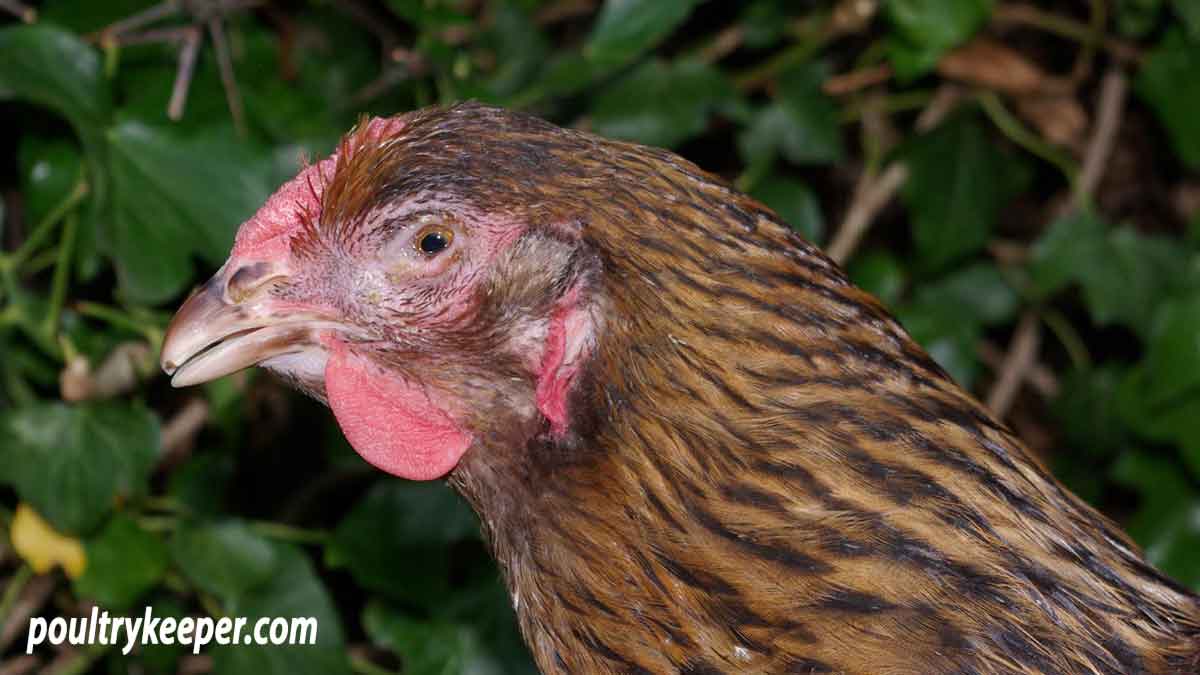
Many backyard flocks these days are carrying Mycoplasma. There are many different kinds of Mycoplasma, but Mycoplasma Gallisepticum (M.G) is the most common.
Mycoplasma Gallisepticum (M.G.) causes respiratory disease and can weaken the bird’s immune system sufficiently to pick up any disease they encounter. Small bubbles in the corners of eyes and swollen sinuses are usually the first sign of Mycoplasma.
Once birds have been infected, they become carriers and remain infectious for life. Some birds seem to have good resistance to M.G., and out of an infected flock, a few may die, others may become ill and recover, and some may not show any symptoms at all. The first time they become ill seems to be the worst, and subsequent outbreaks seem milder.
Transmission of Mycoplasma Gallisepticum
How do chickens or turkeys get it?
Mycoplasma Gallisepticum is a bacteria that is transmitted via droplets from the carrier bird’s respiratory discharge.
Chickens and turkeys can cross infect one another, but other species have their own type of Mycoplasma that cannot cross infect.
It can transmit through hatching eggs (although this is less common from my experience) or from infected dust/bedding material which can also carry the disease.
Mycoplasma is highly contagious and can also be carried into your flock on shoes, clothing and feeders/drinkers etc. Mycoplasma can survive for several hours on these things so if you visit another flock where there could be disease, or you have birds in quarantine that become sick, be sure to follow good biosecurity measures.
Bringing new, perfectly healthy younger birds into an established flock of carriers is typically a problem. New birds can be M.G. free, but the stress of being moved and not having much resistance will cause the bird to become sick after a week or two of arriving, and yet, the established flock appears to be healthy.
The stress trigger for M.G. to occur can be small such as moving birds to different housing, adding new birds, changing diet, parasite infection or even a sudden change in the weather (snow, for example).
The infectious agent survives for only a matter of days outside of the birds.
Commercial operations operate an ‘all in, all out’ system to ensure they do not have problems and good breeders will ensure their flock is free of M.G.
There is no known risk to human health.
Testing
A blood test can be done at your vets to determine if a bird is carrying M.G. The blood samples are usually sent to a specialist poultry laboratory for analysis.
In Ireland, it is advisable to test all new stock that you buy since it is a notifiable class A disease and the Department of Agriculture in Ireland recommend culling all birds that test positive.
Other names
You will hear various names for Mycoplasma Gallisepticum. M.G., Chronic Respiratory Disease (C.R.D.), Roup (especially in the older poultry books), Stress Disease, Infectious Sinusitis (especially in Turkeys).
Symptoms of Mycoplasma Gallisepticum
What to look out for
It is mainly the respiratory system that is affected, but it can also affect the Kidneys.
In growers
In young chickens (growers) you may see the following symptoms, as well as some of the symptoms adult birds, can get if they have Mycoplasma Gallisepticum.
- A loss of appetite.
- Slow growth.
In adult chickens and turkeys
In adult chickens and turkeys, you may see the following symptoms:
- Ruffled feathers.
- Fluid in the eyes (small bubbles, especially in the corners of eyes).
- Coughing, sneezing, ‘Darth Vader’ breathing.
- Gurgling/rattling while breathing.
- A swollen face.
- A strained crow in cockerels.
- A drop in egg numbers from laying in hens.
- Sometimes, a loss of appetite.
- Sweet-smelling breath.
Treatment
Some birds die, some birds are only carriers, and some birds are sick and recover but repeatedly have bouts of illness (not normally as bad as the first time).
Antibiotics from your vet: Tylan, Baytril, or Gallimycin are often prescribed. Treatment needs to be early on for a greater chance of recovery.
The only way to remove the disease from your flock is to cull and start again. This is why you should seriously think about having a strict quarantine period for birds coming into your flock and blood test new birds if your flock is large or of high value.
Do not sell infected birds
Please do not sell birds if they have Mycoplasma Gallisepticum. If we can stop transmission in this way, there will be far fewer cases of the disease.
Prevention
Good biosecurity measures are essential. Try to minimise stress in your flock. Vaccination is possible but is done via an inhaled mist and the equipment to administer this is expensive.
Use a quarantine system and blood tests when bringing new birds into a flock of high-value.
You can keep your birds’ immune systems strong with the right diet. Fresh crushed garlic in food or water and Apple Cider Vinegar also work well.
Other useful articles & guides:
- Garlic for Chickens - I have seen positive results feeding garlic to my chickens.
- Apple Cider Vinegar for Chickens - You can add ACV, a popular tonic to your chicken's water to help keep their immune system strong.
After an infection, disinfect housing and leave it for 2 weeks. Mycoplasmas cannot survive for long in the environment.
Many respiratory problems are labelled as “Mycoplasma” by backyard chicken keepers but there are other respiratory diseases. You can read more about respiratory problems in chickens here.



